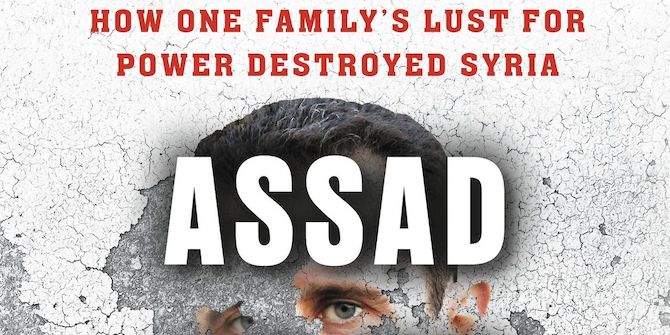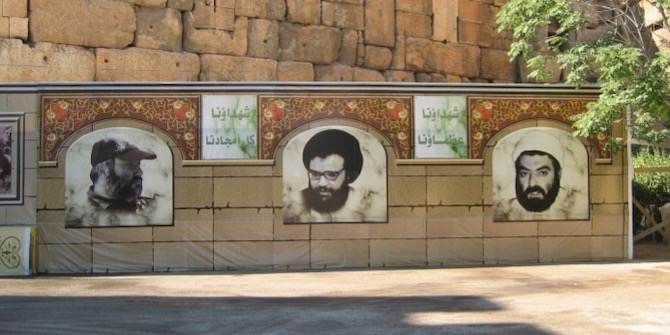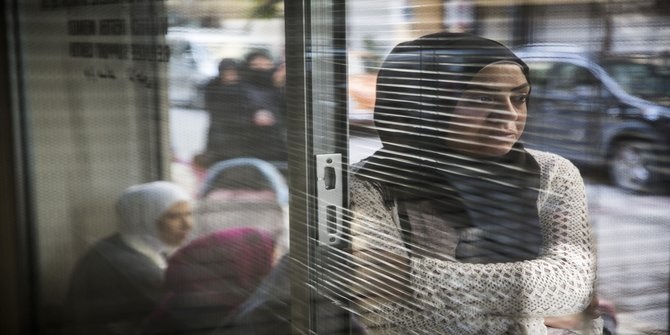by Aitemad Muhanna-Matar

Since the early 1990s, the concept of masculinity has been given more attention by the international humanitarian community, in response to the increasing vulnerability and victimisation of men by war, militarised conflict and displacement in different parts of the world. Yet, the resulting marginalised and victimised masculinities caused by war and displacement are still presented in the literature of the international humanitarian community as part of ‘hegemonic masculinity’, assuming that this concept is homogeneous and represents the natural traits of men in hierarchical societies. The international humanitarian community still associates both marginalised and hegemonic masculinities with violence, following a generalised assumption that men who lose their masculinity through war think that they can regain it through violence, and particularly sexual violence against women.
The inclusion of masculinity in humanitarian interventions’ gender policies and strategies is superficially discussed in several UN agency documents. For example, the 2008 UNHCR Handbook for the Protection of Women and Girls is the foremost document that provides guidelines on the subject in the context of humanitarian interventions, particularly in situations of war and displacement. The Handbook assigns a separate section on how to work with refugee men and boys to promote gender equality and protect women and girls based on international standards. Masculinity – as it is presented in this handbook, and replicated in almost all other UN documents – is ‘associated with bravery, strength, authority, independence, and sexual activity’ (p. 56). Regardless of the different aspects of socio-economic, health and political vulnerability that refugee men experience through war and displacement, men are routinely presented in the UNHCR handbook as the perpetrators of violence against women and girls. The association between the masculinity of refugee men and violence is attributed to a patriarchal and backwards culture. In situations of war and displacement, the handbook notes that refugee men almost always turn to violence against women and girls because war and displacement deprive them of the capacity to enact their masculine ideal, as the primary breadwinner and protector of the family. War and displacement can also generate feelings of uselessness and helplessness that frustrate men and push them towards drugs, alcohol and criminal acts, leading to sexual and physical violence against women and girls at home and in the local community.
To tackle Sexual and Gender Based Violence (SGBV) against women and girls in situations of war and displacement, UNHCR (in partnership with other UN agencies, NGOs and governments) has made its mission to help men shape a new model of masculinity. According to the UNHCR handbook, to promote gender equality in refugee communities, men need to replace the negative mode of their masculinity with a positive non-violent one, which would enable men and boys ‘to empathize with women and girls, builds on their skills and capacities, and empower them’. The handbook also notes that with a civilised conception of non-violent masculinity, men ‘are less likely to become perpetrators of SGBV’ (p. 58). Men’s loss of social, economic and political power through war and displacement, and the replacement of hegemonic masculinity with a marginalised masculinity exemplified by powerlessness, frustration and helplessness, is seen by international humanitarian organisations as an opportunity to undermine the patriarchal model of hegemonic masculinity and replace it with a progressive and civilized one based on the universal principles of gender equality. The problem with this discourse stems from its decontextualised and generalisable assumptions that overlook the actual exercise of men’s agency to reformulate the meaning and practice of hegemonic masculinity within a particular context. This reformulation may not be in line with universal measures of gender equality, but rather the moral virtues of patriarchy. These could include connectivity, intimacy, reciprocity, self-sacrifice and a sense of responsibility towards the family and the wider community.
The documents mentioned above are also the main references guiding the gender policies and strategies of international humanitarian organisations that aim to protect displaced Syrian refugee women, girls, boys and men in Jordan. These organisations label women and children the most vulnerable victims of war due to the dominant patriarchal structure and culture, though this is actually broken down, with many of its cultural aspects dissolved, due to the livelihood crises that follow after displacement. According to UN reports, Syrian refugee women’s resilience is conditioned by their capacity to resist a traditional patriarchal culture, male domination and the hegemonic model of masculinity (which is exploitative and violent). This is to be achieved by granting women economic autonomy and freedom, and facilitating their access to market skills and market-oriented jobs, ignoring the fact that the same market rules and regulations aimed towards absorbing vulnerable women into the jobs market have also left the majority of Syrian refugee men vulnerable and destitute. As for men with physical disabilities and chronic illnesses, they are located with subordinate groups including the categories of gay, lesbian and transgender, whose gender identity, or sexuality, is often not socially and culturally recognised in Arab Muslim societies. This categorisation means that masculinity is inevitably defined in connection with physical capacity. Marginalised men are portrayed in their behaviours as either compliant with hegemonic masculinity and its traits of domination and violence, or they are emasculated (in the sense of losing these traits) as in the case of disability.
The overemphasis on a singular and unitary pattern of hegemonic masculinity and the association of marginalised masculinity with violence is the conceptual foundation that underpins international humanitarian organisations’ gender policies and interventions targeting displaced Syrian refugees in Jordan. For instance, the SGBV Sub-Working Group (SWG), coordinated by the UNHCR, was established shortly after the beginning of the Syrian crisis with the objective of strengthening the SGBV prevention and response in the context of the Syrian refugee crisis in Jordan. Almost all reports produced by the SGBV SWG in Jordan assert that its objective is to promote gender equality based on international standards. The inclusion of men into SGBV interventions has become a necessity, aiming to assist vulnerable refugee men to rid themselves of their violent behaviour that are seen by members of the SWG as inevitably developing in situations of war and displacement.
The 2015–17 SGBV SWG Strategy focuses particularly on domestic violence, specifically the physical and sexual violence perpetrated by intimate partners and other male members of the family. The Jordanian SGBV SWG’s strategy document relies on the standardised IASC guidelines to define the causes of SGBV. According to the strategy document, ‘the underlying cause of SGBV is unequal power relations in society and affects mostly women and girls as a result of their economic, political and social status’. This sentence is followed, in a somewhat superficial manner, with, ‘However, men and boys can also be subject of this type of violence’, but men and boys are reluctant to report SGBV to avoid stigmatisation. As the majority of Syrian refugees who seek humanitarian assistance are women, they are the ones who are reported upon by organisations’ case managers, including their experience of SGBV. Therefore, the Gender-Based Violence Information Management System (GBVIMS), coordinated between many international humanitarian organisations, shows that during the period from May to December 2014, among all survivors of SGBV, most receiving specialised services were women (58 percent) and girls (32 percent). Data from the GBVIMS also shows that most of the incidents disclosed by survivors were perpetrated by members of their nuclear families, mostly by spouses, parents/caregivers and at the survivors’ homes (82 percent of survivors fit into one of these categories). At the same time, the UNWomen report (2013) and International Rescue Committee (IRC) report (2014) show contradictory data that does not support the generalised and decontextualised argument that women are restricted in their movement by a patriarchal culture at home, and that SGBV is primarily perpetrated against women by their intimate partners. The first report shows that women were slightly more likely than men to cite fear, protection concerns, or ‘not [being] allowed’ as the reason for their restricted movement outside the house. The same report shows that the highest risk of SGBV was in open public places, while the lowest was at home.
The SWG’s strategy also assumes that all Syrian refugee women and girls are at a high risk of SGBV by their own patriarchal culture, and that men need to change their patriarchal attitudes and support women to become leaders at home and in the local community. Syrian refugee men are presented in almost all documents as the holders of power, even in the situations of their own extreme vulnerability. These assumptions are necessary for humanitarian actors to legitimise their role as the protectors of women and girls from their men and their patriarchal culture. This ignores the fact that in the context of Syrian refugees’ displacement in Jordan, Syrian refugee men were more exposed to torture, bullying and discrimination in the workplace, in addition to being more at risk of deportation or arrest by the Jordanian police than women, leaving aside the possibility of men also being more marginalised and excluded by humanitarian aid organisations based on the assumption that they are the root cause of women’s disempowerment.
Suggestions for Humanitarian Policy Makers and Practitioners
For the inclusion of men into humanitarian interventions to be effective, sustainable and reflective of the actuality of men’s experiences, humanitarian actors should:
Firstly, stop singularising and unifying the concept of masculinity in association with patriarchal structures of power, domination and violence, and instead give more attention to better understand the complexity of connections between the different forms of masculinities (hegemonic, marginalised, victimised, subordinate) within the particular context of war and displacement;
Secondly, avoid the binary presentation of gendered vulnerability – that women are more victimised by war and displacement than men and thus they are in need of prioritised interventions – and instead seek an accurate investigation of how men respond differently to their own victimisation and marginalisation, and that of women, rather than speculating based on universal and standardised measures;
Thirdly, eschew imposing a standardised concept, or measures, of masculinity, to promote gender equality within the framework of international standards, and give more attention toward exploring the measures that men develop on their own. The imposition of standardised measures is often counterproductive because it denies the capacity, and agency, of men to reformulate and renegotiate their masculinities on their own terms and with respect to their own experiences;
Fourth, stop haphazardly attributing men’s violent behaviour to patriarchal culture. Patriarchal culture has multiple and contradictory values and its hegemonic masculine pattern also has numerous configurations: both positive and negative. Thus, the enhancement of the positive aspects of hegemonic masculine ideals, based on the moral values of patriarchy, may contribute to de-hegemonising male domination and violence and replacing such behaviours with love, care, reciprocity and respect towards women and children. This would be a starting point for a localised long-term strategy for promoting gender equality.
Aitemad Muhanna-Matar organised a 2-day conference at the LSE Middle East Centre entitled ‘Between Institutional Resilience to the Syrian Refugee Crisis and the Resilience of Syrian Refugees’ on 7–8 March 2019. Find out more here.






